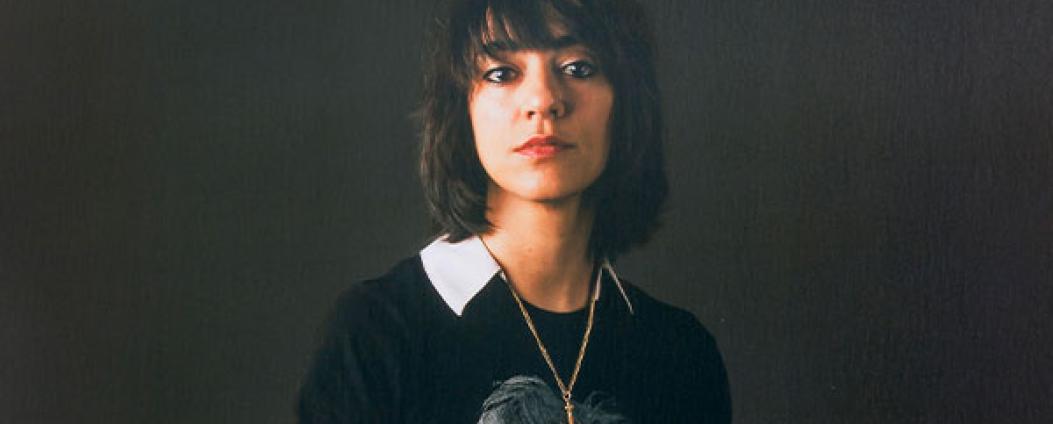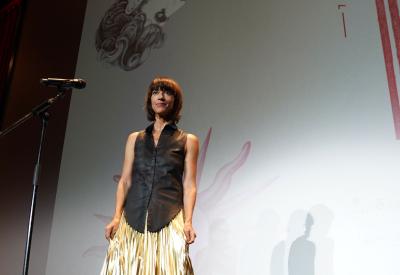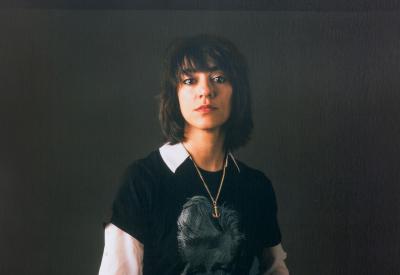- Home
- Latest
- Ana Lily Amirpour

Interview
Ana Lily Amirpour
“The music is really one of my primary tools for thinking”
15 Jun 2022
Reading 10 min.
Interview with Ana Lily Amirpour
Film director, screenwriter, producer and even actress. From a very young age, Ana Lily Amirpour has known how to take on all the roles of film production, letting go of her imagination to lead us through fantastic stories. With three feature films made, Lily is considered one of the most surprising and captivating talents in current fantasy genre cinema.
The birth of a director
When we came to America I was very young… five, six years old. I saw the making of Thriller, a short documentary that shows John Landis and Michael Jackson making this music video. I became obsessed with it. I watched it over and over studying it… repeatedly… I loved watching the process of creating the latex mask for Michael for the werewolf transformation. It was like seeing a magic trick. And I remember how they were choreographing the long dolly-shot where the camera following Michael as he dances and walks along side of the girl… all these details felt like my first film education… and another important detail I remember was that John Landis was having so much fun in that video. He was in a joyous state in all parts of creation. And I feel that energy when I’m onset now. It is joyful to be creating on a movie set.
It’s interesting to contemplate how you start to make films. Watching movies is a big part of everyones life, but seeing this video really opened my eyes to the other side of how it’s made and it was a realization that I could make this type of magic also. I could put on an elaborate show. Around that age, I started making plays and I would do everything: I designed the costumes, the makeup FX and created the sets and then I would act in them and bring my family members to also act in them. And then when I was 12 and my dad bought a high eight camera. And I started making movies and commercials.
So it does feel like my first film schools experience was seeing the making of Thriller; because when you could see behind the trick you want to make your own trick.
Love for Fantasy
When I think about the movies that I love, I always think back to my childs mind, and the first movies I loved as a kid, which I also still love as an adult. One of these is The Neverending Story. It was usually based in fantasy, some kind of a fairy tale, adventure fantasy. Back To The Future was another big influence. And when I think about the soul of these movies today I realize both movies are about a character taking charge of his own destiny; they are really about freedome, which is such a central theme in all of my work today. These films were about creating your own future and having control of what's possible by harnessing the power of your imagination.
The first shooting
I made my first films when I was 12 and I did everything… I was recreating commercials that were on television and I was also making very short horror movies. I don't remember thinking anything about the result, or the audience or if it was ‘good’ or ‘bad’. It was a pure state of creation, in the moment. That’s the beautiful thing about when you're 12 is you just decide you're going to do something, you have the need and it’s pure and you just do it. With no doubts or fears. This is the optimal state to create. And what I always hope to feel like, like a childs openness and pure energy.
Later in life, after I finished art school, where I studied painting and sculpture, I started making short films again. And finally moved to LA to study screenwriting at a film school. And I do remember the first short film I made in the legitimate way, with a crew and everything… and it was a very small crew. But still, I remember the first moment onset for the first shot. I remember standing there and I saw so many people on the set, and I didn't really know what everyones job was. Because you know, I was used to doing everything, like making the costumes, making the set doing everything… I even acted in the films! And I was stunned thinking, who are all these people? What's their job? Because you know, in film school I studied writing, not directing. So I was never told all the parts of a crew, I just learned directing from doing it. So, I didn't know what assistant camera was, what second assistant camera was… I was just amazed that it was such a technically organized dance of so many people thinking together. It was amazing. And when I was onset today, with so many people surrounding me. It still is amazing.
A girl walks alone…
My first film, A Girls Walks Home Alone at Night, came from a very specific focused idea, and character, it was something that had no confusion, because I wasn't even slightly questioning any aspect of the film. I was 100% sure of every part of the story. I knew everything I wanted to do and how I wanted to do it; and it was very specific and extreme. It's black and white film. It's an Iranian story. The actors, the music, everything was clear for me. I think that’s why in some ways it was easy to make this film… even though it was quite unconventional in every detail, it was clearly it’s own thing. And the people who got it, got it. That is why the people who said yes to the project were very inspired and on board.
'The Bad Patch'
My second feature film had nothing previous one. It's like if you had one boyfriend, your next boyfriend isn't necessarily a rebellion of your first boyfriend: it's just whoever you're in love with. The Bad Patch is a very deep observation for me of the American dream. Looking at the modern American society as a metaphor, as an allegory of how to show the culture of people today, which is imploding in many ways. This was how I could explore the decay of the American dream.
The violence, the separation of democracy in modern day society and culture… was very clear to me. And also the opportunity to choose what you want to be. As a person who came to America, as an immigrant, I came here and learned how to be American. Rather than starting out here, I understood America very much as a place for outsiders. And realized a feeling that we are always searching for where we belong. That’s why I understand very much the fight and the competition to find your way forward, or in any direction. All that stuff is in the story of America, the beauty of it is that you can choose to be whatever you want… and I also see that becomes the problem and tension… when different choices collide in violent ways.
The question of the movie, for me was: if you are a product of this system, can you change your logic and can you change your desire to find something different in that system? Or does it just keep recreating itself? And producing the same product. And yes, this is a complicated question with no one answer. So for that reason, The Bad Patch is a complicated film.
And then came 'Mona Lisa'
Yes, Mona Lisa… and I can see that in all my films, I am looking at the idea of freedom. I am looking at characters that live in a world that creates systems that often stop them from feeling free. And in order to find yourself and to move forward or to move in a different direction to change your reality, to change what your future can be, you must break from the past, rebel from the system, and find a way out.
The thing about freedom is a constant process, to deconstruct and reconstruct what you believe freedom is. To understand freedom you have to define freedom. And that definition constantly changes as each day passes. If I think about all my films, I can see characters who defy categorization. They reinvent themselves and are in control of their own identity in a way, and constantly reinventing their identity and changing their situation. To me this is ultimate freedom. To search and constantly be looking for freedom, is itself a form of freedom.
The characters in my films, physically, they are not what you expect. If you judge them based on the surface, you would be very, very wrong. And certainly in Mona Lisa, she changes constantly how she looks, and it allows her to move in different ways. This is especially important for a female, when we are so defined by the outter layer, the superficial layer. But for her… she constantly shifts form and it’s exciting to see her be whatever she wants to be.
The spark of creation
Usually, there's one character and one image of a character. In my first movie, it was The Girl, the vampire. And it was the chador and the skateboard because I had one, and wore it and then I got on a skateboard, and I instantly thought -this is an iranian vampire.
In The Bad Batch, I had a very difficult heartbreak and time in my life and I had this image in my mind, of a girl missing an arm and a leg and bleeding in the middle of the desert… but she would survive. And the story grew around that. And then, with Mona Lisa I saw the opening of the film. I saw a girl trapped in a box, discarded from the world. And no one understood who she was. People fear her because she’s different. And in this film, I really wanted to believe that amongst all the chaos of modern-day reality, there can be beautiful connections and friendship between people. True friendship that makes you feel, seen. To me, friendship is like a unicorn. A rare and beautiful thing that should be treasured. So, I was really looking for the joy in the chaos of humanity in Mona Lisa. It really gave me a lot of joy making that movie. The Bad Batch took me into the darker aspects of humanity, had the opposite effects.
Choosing the soundtrack
Music starts to come right at the beginning. As I see first image I will start to listen to songs. And listen to hear like the general feeling of a mood or the story or one of the characters. I start gathering it in a playlist and there's a lot of music in the process of writing. Much of it is just an exploration tool. And some of it ends up in the films.
It’s really one of my primary tools for thinking. Making a movie is like opening a door into this dimension where this world exists and the music is like putting money into the jukebox, and it keeps playing and making the world bigger and bigger. So, I gather all this music and when the script is more complete, I go back to the music and certain songs are clearly part of part of the story or part of a certain moment. And they are written into the script. My scripts are always sent with playlists, and I believe to fully ‘read’ the script you have to listen to all the music along the way.
Every movie wants a different sound. The music in a way is the soul of a film so it's like in A Girl Walks Home Alone at Night, I had a lot of really cool, modern Iranian indie rock and a few classic old Iranian pop songs, and the beautiful music of Federale as the spine, and even some crunchy German techno; and then in The Bad Patch the soundscape was more psychedelic like it was a lot of music from Darkside which felt a kind of feeling of what this desert would feel. And Mona Lisa was about life and vivid and full of energy, so it’s got this driving electronic synth sound, like music from 80s and 90s fantasy films. With a lot of energy. Every movie allows me to discover all this new music and because I tend to go towards artists that aren't that well known and maybe nobody's heard of, that's exciting, because I can share their music with a larger audience.
Filmmaking TV
The first thing I did in TV was a show called Legion which is a very psychedelic and experimental superhero show. It's extremely daring filmmaking, crazy technical shots, and wild stuff with the camera, the wide lenses and with the sets and everything. It was a joyful intro into filmmaking. And I feel lucky to have entered into the realm of TV with something like that. I look for shows that are daring and some aspect of it will excited me. As a filmmaker I really wants me to play with those tools and have fun and do something. And then it becomes creative. Of course, it's a TV show that already exists, you're not making all the primary decisions or setting the look like with the lenses and the lighting, and because of that it takes a lot of pressure off: you just go in and play with these tools in a creative Canvas. You really learn about things that are possible and what you can do and help them tell their story. I love TV. I like taking the pressure off you (it's not your script). You just go in there as an ally to help them do a good episode and have fun learning like some new tricks.
Working on Guillermo del Toro’s Cabinet
It was one of the most joyful creative experiences I've had so far. Guillermo is such a supportive and encouraging producer. He really took the approach that I could treat this as a movie, and shape it however I want. So for me this does feel like my fourth movie in many ways. This anthology is completely separate, stand alone stories. Unrelated. They don't look the same: different directors, different writers. So, it really does feel like a movie.
My episode is called The Outside and it stars wonderful cast, Kate Miccuci, Martin Starr and Dan Stevens. It’s a very surprising story and I look forward to seeing what you think. Should be out later this year.

